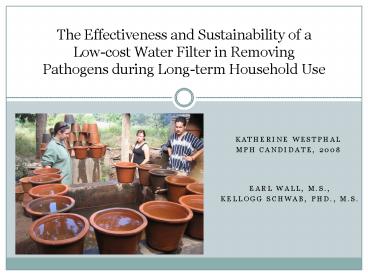Katherine Westphal - PowerPoint PPT Presentation
1 / 12
Title:
Katherine Westphal
Description:
The Johns Hopkins Center for a Livable Future. Ron Rivera, ... Earl Wall, Kellogg Schwab, Kristen Gibson, Stephanie Guo, Casey Branchini and Jimmy Schissler ... – PowerPoint PPT presentation
Number of Views:52
Avg rating:3.0/5.0
Title: Katherine Westphal
1
The Effectiveness and Sustainability of a
Low-cost Water Filter in Removing Pathogens
during Long-term Household Use
- Katherine Westphal
- MPH Candidate, 2008
EARL WALL, m.S., Kellogg Schwab, PhD., M.S.
2
Ceramic Water Filter (CWF)
- Technology developed in Guatemala in 1981
- Potters for Peace promotes CWF
- Filters are produced by local organizations
- Manufactured in 23 factories throughout 20
countries - Worldwide over 300,000 sold
- Organizations promoting CWF include Save the
Children, UNICEF and Oxfam
3
CWF production
- Made from locally available clay, screened
combustible material (sawdust or rice husks) and
water - Pressed into bucket shape with a hydraulic press
- Fired for 8-12 hours in Mani Kiln
- Filtration flow rate (1-2.5 Ltr/hr)
- Painted with colloidal silver
- Sold with plastic receptacle and spigot for 15
(small) and 20 (large)
4
Background
- Research to date -
- Non-peer reviewed studies have found
- CWF removes between 98-100 bacteria
- effective in removing protozoa although the virus
removal is minimal - Concerns
- Effectiveness of the filter to remove water-borne
pathogens - Possible quality control issues within and
between manufacturing facilities
5
Research objectives
- Quantify the effectiveness of the CWF to remove
water-borne pathogens in the laboratory and in
the field - Evaluate the long-term sustainability of the CWF
- Determine if the CWF should be promoted by
organizations as a POU water treatment system
6
Study design
- 3 Parts
- Laboratory
- tested bacteria, virus and protozoa removal of 24
CWFs from Honduras - Field survey -
- a cross-sectional survey of households in
Nicaragua that received a CWF - Field assessment
- in-situ tests of CWF effectiveness to remove
bacteria
7
Research findings
- Laboratory (15 CWFs with silver)
- Field
- 53 (23/43) of filters removed 100 of E. coli
- 78 (34/43) of filters removed gt 95 E. coli
- 9.3 (4/43) of households had more E. coli in
filtered water than pre-filtered water
8
Research findings
- Cross-sectional survey (167 households)
- 48.5 of households had stopped using filter
daily - Among households not using the CWF, the primary
reasons were - broken spigot ( 58.0)
- broken ceramic filter (40.7)
- broken receptacle (30.9)
- Even among households using the CWF, 31.4 had a
broken spigot - Only 26.3 of households knew where to purchase
CWF spare parts - 86 of households reported that the CWF provided
enough water for their family to drink - All households surveyed liked the taste of the
filtered water - The majority of households reported that they
liked the CWF because it cleaned the water and
kept their family healthy
9
Sustainability
- Social/Cultural
- People like the taste of the filtered water and
appearance of the filter - Households consider the CWF beneficial enough to
pay for it - Economic
- Provides employment for local potters
- A one-time cost if unit does not break
- Technical
- Effectiveness
- Significantly reduces bacteria and protozoa in
water - Does not effectively remove viruses and there is
no residual protection - Durability
- The ceramic filter, spigot and receptacle are
fragile and break easily - Spare parts are not readily available
- Environmental
- Uses locally available materials and fuel
efficient kilns for firing filters
10
Conclusions
- Laboratory -
- CWF improves the quality of water but it does not
consistently remove water-borne pathogens to meet
USEPA standards - Field -
- In general, the CWF improves household water
quality - Without modifications to the spigot and
receptacle, long-term sustainability will not be
achieved - Overall -
- Necessary to consider the social, economic and
environmental constraints of a country before
defining water quality standards
11
Recommendations
- CWF -
- Adaptations to the spigot and/or receptacle of
the CWF - Increase availability of CWF replacement parts
- Research -
- Compare effectiveness of filters across
production sites - Longitudinal study of diarrheal prevalence
comparing households with a CWF to those without - Quality assurance -
- Establish QA protocols for CWF production
- Develop a certification process for
locally-produced CWFs
12
Acknowledgements
- The Johns Hopkins Center for a Livable Future
- Ron Rivera, Potters for Peace
- Save the Children Canada, Nicaragua
- Earl Wall, Kellogg Schwab, Kristen Gibson,
Stephanie Guo, Casey Branchini and Jimmy
Schissler - Joan Kub and Sara Groves































